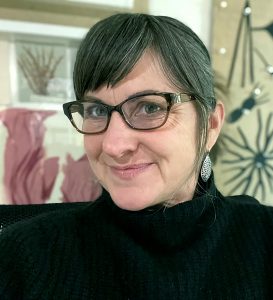Jennifer Parker —Professor and Founding Director of OpenLab Collaborative Research Center, UC Santa Cruz

Jennifer is an artist and educator who combines visual art and humanities practices with science, engineering, and technology at the University of California, Santa Cruz. As a Professor of Art and Founding Director of the OpenLab Collaborative Research Center, she creates and facilitates interdisciplinary opportunities between the arts and sciences. Currently she is working with art faculty there to design a new graduate program, Environmental Art and Social Practice, that will launch in Fall 2020. The primary goal of the program is to produce meaningful creative research, instrumental to the future of a rapidly changing planet and society. Her collaborative project, ‘The Algae Society: Bio Art and Design Lab,’ was recently featured at the December 2019 UN Climate Change Conference (COP25) in Madrid with an exhibit entitled Entanglement.
What is the educational and career path that led to your current career?
Since I was a child I’ve been making and playing with natural materials. I always loved collecting specimens from nature and observing living things in the environment around me. I studied sculpture as an undergraduate at the University of California, Santa Barbara in the College of Creative Studies, a unique college for self-directed students interested in creative research inspired by the arts and the sciences. For graduate school I went to Rutgers University in New Jersey, which cemented my desire to develop interdisciplinary practices with the arts as research and to teach across disciplines.
How did you become interested in environmental work?
The biological sciences probably influence my work the most. I love looking at structures in nature, finding out how things work and what is happening on the inside. Art, like nature, is experiential — a kind of embodied knowledge or experience that seeps in through your senses. As a young artist I was inspired by the environmental art movement of the 1960’s and 70’s, when sculptors explored natural materials and moved their work outside onto the land to create earthworks and installation art. Today I create artworks designed to raise awareness of environmental issues. Often these works express scientific data obtained through collaborations with scientists and engineers.
What environmental issues are of most concern to you?
I’m interested in using science to help communicate with the general public — using art to encourage sustainable practices, sharing knowledge, and inspiring people to want to learn more about the environment. As an educator I’m most interested in using my position to influence the next generation to be engaged stewards of the planet and agents of change in helping to reduce human impact on ecosystems. As an artist I’m working with an international collective of artists and scientists focused on algae as a non-human research partner, to build compassion and understanding for this large, diverse group of photosynthetic organisms responsible for 50% of the world’s oxygen. We work with local artists to produce art about algae and the effects human behavior is having on them.
Want to connect with Jennifer? You can connect with her personally on LinkedIn and Facebook, as well as with OpenLab on Twitter and Facebook. Also, check out the Open Lab webpage and Jennifer’s UCSC faculty page.
